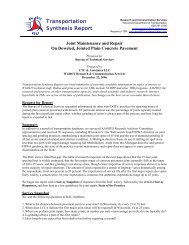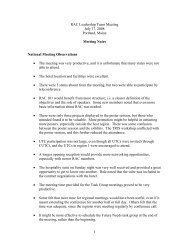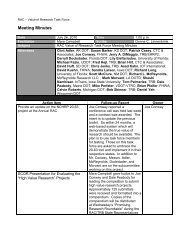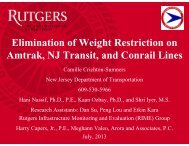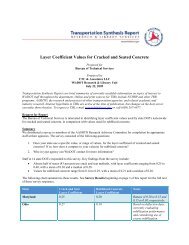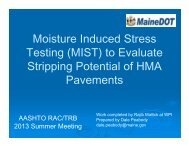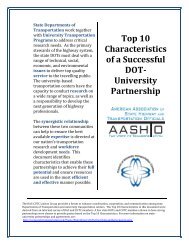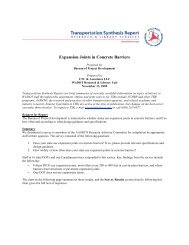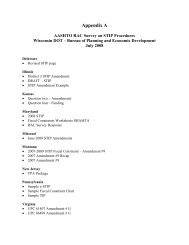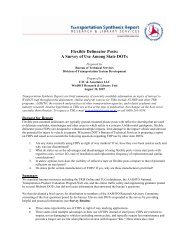Highway Maintenance Response Time Standards
Highway Maintenance Response Time Standards
Highway Maintenance Response Time Standards
Create successful ePaper yourself
Turn your PDF publications into a flip-book with our unique Google optimized e-Paper software.
September 10, 2001 MAINTENANCE MANUAL 5-791.300_________________________________________________________________________________________________SNOW AND ICE CONTROL5-791.3005-791.301 INTRODUCTIONThe removal of snow and ice from the trunk highways in Minnesota is one of the most important jobs confronting maintenancepersonnel during the winter season. Putting a priority on snow and ice removal prevents a complete shutdown of highwaytransportation, especially during severe snow and ice storms. Minnesota motorists have invested large sums of money in Mn/DOTtrunk highways; therefore, they expect to travel on well-maintained roadways throughout the year. Mn/DOT realizes that a largesegment of our economy is based on highway transportation and we must utilize reasonable means to minimize hazards, slippery roadsurfaces, costly delays, and abnormal energy usage to the highway user.Safety for the motorist and serviceability of trunk highways are the primary considerations of Mn/DOT. Snow and ice removaloperations must be carried on so as to provide reasonable safety for the public as well as for employees.Effective snow and ice control is achieved through planning, preparation, and execution of good tactical procedures. This chapteroutlines elements that affect those three functions.5-791.305 GUIDELINES STATEMENTMn/DOT is committed to providing the traveling public with the level of service for snow and ice control that is described in theoperation guidelines of this manual. The purpose of the guidelines is to promote statewide continuity and uniformity in the wintermaintenance of the trunk highway system. The recommended levels of service should be interpreted as standard operating procedures.In certain situations, however, the Area <strong>Maintenance</strong> Engineers will exercise judgement where maintenance requirements differ fromthe guidelines.The Area <strong>Maintenance</strong> Engineer will determine actual snow plow routes using the guidelines in this manual to establish the mostefficient routes. In order to do this, consideration must be given to many factors not accounted for in this guide. These factorsinclude: personnel abilities and capabilities, physical location of personnel, equipment dependability, location of truck station, terrain,the plowing of information centers and rest areas, plowing left shoulders adjacent to concrete median barriers, and plowing frontageroads. In addition, Area <strong>Maintenance</strong> Engineers must take into account overtime pay and other provisions in Mn/DOT’s unioncontracts, availability of equipment and availability of additional staff for maintenance work during the winter months. The level ofservice for snow and ice control is directly related to personnel, overtime, equipment, materials and desired condition of drivingsurface. If any factor varies, the others must be adjusted accordingly.Prior to establishing the guidelines, surveys of the public were conducted to determine whether we were providing an acceptable levelof snow and ice removal. Surveys conducted in 1994 and 1996 covered year round maintenance operations and a 1999 surveycovered snow and ice operations exclusively. Results of the surveys indicate the following:Snow and ice removal continues to be a high priority to the public. Our current level of maintenance effort is satisfactory.The 1999 survey attempted to identify drivers comfort and acceptance of six different service levels of snow and ice removalimmediately after a snow event and at approximately 9 and 15 hours after the event. Only two levels (1. Driving lanes barewith centerline and edgelines showing and 2. Driving lanes bare with centerline and edge lines covered) had a high level ofacceptance with drivers in most scenarios. The survey also recommended that Mn/DOT achieve the second level on allroutes prior to removing snow and ice from the centerlines and edgelines. This is because of the relatively high level ofsatisfaction with the top two levels of service and the small difference in driver satisfaction between the top two levels ofservice.



